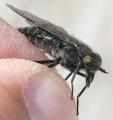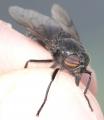Diptera.info :: Identification queries :: Diptera (adults)
Who is here? 1 guest(s)
|
Campylochaeta (Elpe) sp. (Tachinidae)
|
|
| Rui Andrade |
Posted on 06-12-2007 12:23
|
|
Member Location: Portugal Posts: 3123 Joined: 19.06.07 |
Is it possible to find out what this species is? host: Pseudoips prasinana location: Vila Nova de Gaia, Portugal date: 2007/12/06 size: 4-5 mm   
Edited by Rui Andrade on 11-12-2007 11:02 |
| Zeegers |
Posted on 07-12-2007 10:04
|
|
Member Location: Soest, NL Posts: 19002 Joined: 21.07.04 |
Great pictures, still difficult to ID. Did you collect the specimen ? So, let me think out loud: it's either Exoristini or Blondeliini and the eyes are very hairy. In Exoristini, the only candidate is Phorinia aurifrons, which was erect apical scutellars, and this one doesn't. So Blondeliini ? Let me ask a question: it seems the ocellar bristles (the pair of strong bristles near the frontal ocellus) are reclinate ?? Is that correct ? Theo |
|
|
|
| Rui Andrade |
Posted on 07-12-2007 10:44
|
|
Member Location: Portugal Posts: 3123 Joined: 19.06.07 |
I believe the ocellar bristles are reclinate, but I don't know exactly what being reclinate is (because I believe all bristles will have a certain degree of reclination). Here you have a close up: I have the specimen with me (it's still alive). |
| Zeegers |
Posted on 07-12-2007 12:35
|
|
Member Location: Soest, NL Posts: 19002 Joined: 21.07.04 |
Reclinate means: oriented backwards. The opposite is proclinate. These are indeed reclinate, which is very unusual. I have been barking up the wrong tree. I think I know what it is, need to check database Theo |
|
|
|
| Paul Beuk |
Posted on 07-12-2007 12:45
|
|
Super Administrator Location: Netherlands Posts: 19403 Joined: 11.05.04 |
reclinate![header=[reclinate] body=[bent backward (usually used to indicate curvature of setae)<br /><img src='../infusions//terms/images/no_image.gif' style='vertical-align:middle;' />] delay=[0] fade=[on]](../infusions/terms/images/help.gif) - proclinate - proclinate![header=[proclinate] body=[bent forward (usually used to indicate curvature of setae)<br /><img src='../infusions//terms/images/no_image.gif' style='vertical-align:middle;' />] delay=[0] fade=[on]](../infusions/terms/images/help.gif) . Always try the Glossary and if it is not there and you think it needs to be there: submit it (if you don't know what it means leave the description empty). . Always try the Glossary and if it is not there and you think it needs to be there: submit it (if you don't know what it means leave the description empty).
Paul - - - - Paul Beuk on https://diptera.info |
| jorgemotalmeida |
Posted on 07-12-2007 14:55
|
|
Member Location: Viseu - PORTUGAL Posts: 9296 Joined: 05.06.06 |
and check the overviews section.  |
| Zeegers |
Posted on 07-12-2007 14:58
|
|
Member Location: Soest, NL Posts: 19002 Joined: 21.07.04 |
Indeed, my thoughts are correct, it is in the genus Campylochaeta, subeenus Elpe. Campylochaeta is a difficult genus. Please do collect the specimen and if possible try to expose the male genitalia. Theo |
|
|
|
| jorgemotalmeida |
Posted on 07-12-2007 15:00
|
|
Member Location: Viseu - PORTUGAL Posts: 9296 Joined: 05.06.06 |
One suggestion. Put the host and the fly together in one photo. It would be very interesting to see some photos like this. Of course, the things are not that easy, but it is just to illustrate some relationships. |
| Rui Andrade |
Posted on 07-12-2007 15:47
|
|
Member Location: Portugal Posts: 3123 Joined: 19.06.07 |
Thank you Theo. I can't expose the genitalia because I don't have either the knowledge nor the equipment. Furthermore I don't know how to pin it. What do I do? Maybe send the specimen to you? You tell me that reclinate bristles are unusual, does this mean that this genus is rare? Edited by Rui Andrade on 07-12-2007 15:49 |
| Rui Andrade |
Posted on 07-12-2007 16:02
|
|
Member Location: Portugal Posts: 3123 Joined: 19.06.07 |
Jorge, the best I can do is joining two photos in one |
| Zeegers |
Posted on 07-12-2007 17:03
|
|
Member Location: Soest, NL Posts: 19002 Joined: 21.07.04 |
Ok, if you can't pin it, put the fly in alcohol. I will send you a PM. Theo |
|
|
|
| Zeegers |
Posted on 28-12-2007 20:40
|
|
Member Location: Soest, NL Posts: 19002 Joined: 21.07.04 |
Rui, as you have noticed, I'm back. I did have a thorough look at the specimen. From the known species, it can only be C. inepta. However, it has a feature never seen (by me) in C. inepta, or any other Campylochaeta, for that matter: marginal bristles on syntergite 1&2. The handbooks (Mesnil in Lindner) also claim that this feature does not occur in Campylochaeta. I did study the genitalia: they are similar (inepta and yours), but not identical. So, I need to consult a real Campylochaeta expert. Theo |
|
|
|
| Rui Andrade |
Posted on 29-12-2007 12:05
|
|
Member Location: Portugal Posts: 3123 Joined: 19.06.07 |
Ok, thank you Theo. I will wait anxiously for the results. |
| Zeegers |
Posted on 07-01-2008 13:19
|
|
Member Location: Soest, NL Posts: 19002 Joined: 21.07.04 |
It is now confirmed: even the real expert has never seen a Campylochaeta with marginal bristles on syntergite 1&2. So, we are left with 2 option: either an highly aberrant specimen of C. inepta, or a new species. The latter conclusion is rather bold, if based on 1 specimen only. So, Rui, get more !! Theo |
|
|
|
| Rui Andrade |
Posted on 08-01-2008 21:35
|
|
Member Location: Portugal Posts: 3123 Joined: 19.06.07 |
Thank you Theo  ! !Is there any other way to confirm it's a new species other than by collecting more specimens? Of course I will continue to collect more tachinids from their hosts, I do that for pleasure  . I'll be specially focused on the larvae of Pseudoips prasinana. . I'll be specially focused on the larvae of Pseudoips prasinana. |
| Zeegers |
Posted on 08-01-2008 21:53
|
|
Member Location: Soest, NL Posts: 19002 Joined: 21.07.04 |
I have just had another very good look at the specimen and let me put it this way: if you forget about the marginals the differences between individuals from The Netherlands is bigger than the difference between yours and an average Dutch guy of C. inepta. So, I quit: the falsifiable statement is that the marginals in your specimen are accidental. Keep up the good work with rearing Tachinids from hosts ! Theo |
|
|
|
| Rui Andrade |
Posted on 08-01-2008 22:11
|
|
Member Location: Portugal Posts: 3123 Joined: 19.06.07 |
But what about the genitalia? You said that they were not identical. |
| Rui Andrade |
Posted on 08-01-2008 22:24
|
|
Member Location: Portugal Posts: 3123 Joined: 19.06.07 |
I'm taking the opportunity to show you the pupa of this specimen. As you can see the pupa has a strange yellow bump. |
| Zeegers |
Posted on 09-01-2008 09:28
|
|
Member Location: Soest, NL Posts: 19002 Joined: 21.07.04 |
What I noticed on the difference in dutch material being larger than between the averaged dutch guy and your specimen, applies to the genitalia as well. Theo |
|
|
|
| Rui Andrade |
Posted on 09-01-2008 11:38
|
|
Member Location: Portugal Posts: 3123 Joined: 19.06.07 |
Ok, thank you Theo. |
| Jump to Forum: |













